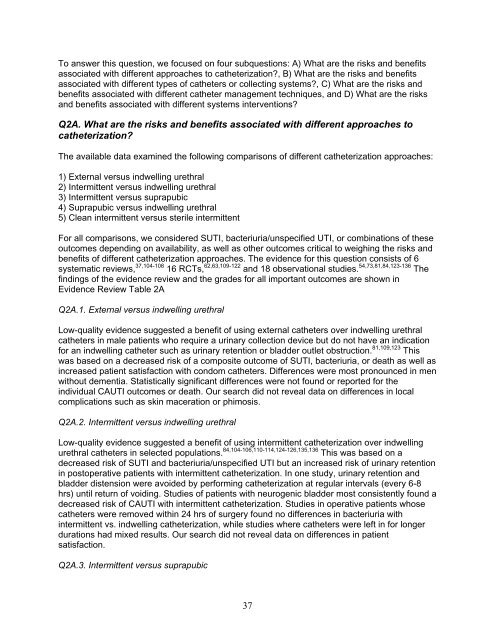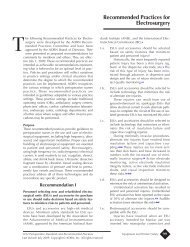2009 CAUTI guidelines - Centers for Disease Control and Prevention
2009 CAUTI guidelines - Centers for Disease Control and Prevention
2009 CAUTI guidelines - Centers for Disease Control and Prevention
Create successful ePaper yourself
Turn your PDF publications into a flip-book with our unique Google optimized e-Paper software.
To answer this question, we focused on four subquestions: A) What are the risks <strong>and</strong> benefitsassociated with different approaches to catheterization?, B) What are the risks <strong>and</strong> benefitsassociated with different types of catheters or collecting systems?, C) What are the risks <strong>and</strong>benefits associated with different catheter management techniques, <strong>and</strong> D) What are the risks<strong>and</strong> benefits associated with different systems interventions?Q2A. What are the risks <strong>and</strong> benefits associated with different approaches tocatheterization?The available data examined the following comparisons of different catheterization approaches:1) External versus indwelling urethral2) Intermittent versus indwelling urethral3) Intermittent versus suprapubic4) Suprapubic versus indwelling urethral5) Clean intermittent versus sterile intermittentFor all comparisons, we considered SUTI, bacteriuria/unspecified UTI, or combinations of theseoutcomes depending on availability, as well as other outcomes critical to weighing the risks <strong>and</strong>benefits of different catheterization approaches. The evidence <strong>for</strong> this question consists of 6systematic reviews, 37,104-108 16 RCTs, 62,63,109-122 <strong>and</strong> 18 observational studies. 54,73,81,84,123-136 Thefindings of the evidence review <strong>and</strong> the grades <strong>for</strong> all important outcomes are shown inEvidence Review Table 2AQ2A.1. External versus indwelling urethralLow-quality evidence suggested a benefit of using external catheters over indwelling urethralcatheters in male patients who require a urinary collection device but do not have an indication<strong>for</strong> an indwelling catheter such as urinary retention or bladder outlet obstruction. 81,109,123 Thiswas based on a decreased risk of a composite outcome of SUTI, bacteriuria, or death as well asincreased patient satisfaction with condom catheters. Differences were most pronounced in menwithout dementia. Statistically significant differences were not found or reported <strong>for</strong> theindividual <strong>CAUTI</strong> outcomes or death. Our search did not reveal data on differences in localcomplications such as skin maceration or phimosis.Q2A.2. Intermittent versus indwelling urethralLow-quality evidence suggested a benefit of using intermittent catheterization over indwellingurethral catheters in selected populations. 84,104-106,110-114,124-126,135,136 This was based on adecreased risk of SUTI <strong>and</strong> bacteriuria/unspecified UTI but an increased risk of urinary retentionin postoperative patients with intermittent catheterization. In one study, urinary retention <strong>and</strong>bladder distension were avoided by per<strong>for</strong>ming catheterization at regular intervals (every 6-8hrs) until return of voiding. Studies of patients with neurogenic bladder most consistently found adecreased risk of <strong>CAUTI</strong> with intermittent catheterization. Studies in operative patients whosecatheters were removed within 24 hrs of surgery found no differences in bacteriuria withintermittent vs. indwelling catheterization, while studies where catheters were left in <strong>for</strong> longerdurations had mixed results. Our search did not reveal data on differences in patientsatisfaction.Q2A.3. Intermittent versus suprapubic37
















